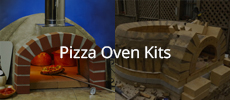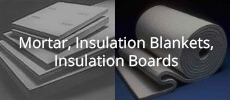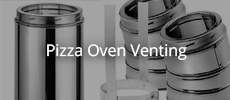You could try applying a stucco/render coat directly onto the blanket, but it is a very poor substrate to work to. A vermicrete layer as well as providing additional insulation, sets up firm and covers bumps in the blanket, particularly if the top of the oven has an extra layer which creates a step (as in post #261)
X
-
Thank you Gulf and david s for the advice.
There is one more area I have questions on before going too much further. This pertains to accounting for material movement during heating and cooling, particularly where different materials are interacting around the base of the chimney.
Elsewhere I've read that the oven dome may move during heating and cooling. I assume that the insulation layer helps to allow this movement without cracking the vericrete or stucco layers of the dome.
I have also allowed about 1/2" gap between the dome and opening arch which will be sealed with fiberglass stove gasket material. It's pretty tight but should allow for some minor flexibility.
Over the interior and exterior arch I will have a Stainless steel transition to the chimney, and because this connects to both the interior and exterior arches, I have my doubts about the best way to attach this piece. I'm thinking of using fiberglass tadpole tape, as I think it should help provide a good seal with some flexibility to isolate interior dome movement from the exterior arch and the vermicrete and stucco layers.
Finally, I intend to surround the base of the ss chimney transition with vermicrete and stucco in the back the insulation till butt up to the ss transition piece. My plan is to leave only the front face of the exterior arch exposed.
I am a little concered that as these different components heat and cool and interact I could start having issues.
Can anyone see any yellow or red flags?
Thank you!
My build thread: https://community.fornobravo.com/for...-pdx-42-update
Comment
-
I think that you have all of it covered as for expansion of the actual dome.The CFB is doing that. However, you need to make a place for the steam to escape during curing if you haven't included that in your design. Also, there will need to be something that will performs as an expansion joint between any ss steel and any masonry including the vermicrete. As for actual attachment to the chimney, I would like to see the "transition piece that you are using. Usually, it is just a heat resistant gasket that is homemade. Where ss bolts are used for the actual anchoring, oversized holes through the ss a good practice to allow for expansion.Joe Watson " A year from now, you will wish that you had started today" My Build Album / My Build
Comment
-
Gulf - well noted on your advice. I do have a plan for a steam vent in vermicrete/stucco at the top of the dome. I've purchased a marine grade stainless steel mushroom cap which should provide sufficicient ventilation without letting anything in.
As for the transition piece, I had not planned to use any hardware for anchoring, although that is feasible. My thought was to use this fiberglass tadpole gasket (picture attached) with 2000F rated adhesive. This example features a 3/4" bulb diameter. I intended to glue the tail piece to the bricks and securing the bulb piece to the inside of the SS material ould provide both flexibility and a good seal. I suppose I could also provide some spacer material around the transition piece and use someting like this fiberglass gasket to seal that gap too.
Incidentally, I am working with a local fireplace guy on the transition piece. This guy has in business since the 70s and has accumulated a lot of vintage stove material over the years. He proposed salvaging a cast iron transition piece that integrates with a vintage stove model he has from his stock, but only if it fits.
I am a little skeptical about this idea. For one thing, cast iron is heavy, and I'm not sure if I want all that weight resting on the opening arch. Secondly, I don't know what that would do with respect to movement of the dome. Instead of being able to slide, I'd be afraid that lateral pressure would transfer through the cast iron and onto the opening arch.
Any thoughts? Am I good to be skeptical on this or is cast iron a good idea if the size works?
Thanks!My build thread: https://community.fornobravo.com/for...-pdx-42-update
Comment
-
With those choices and those dimensional restrictions, I'd do a third layer of 1" blanket. Then stucco lath (expanded damond mesh). Then stucco.Originally posted by Macrinehart View PostMy challege is that I'm nearly to the edge of my hearth in the back, I have about 1.5" available now for both the vermicrete and stucco. Can I skip the vermicrete and go directly to stucco, or perhaps thin down the vermicrete layer? Or would I be better off adding an extra 1" of blanket around the entire oven and then going straight to stucco?
When I built my oven I thought the lath would be a pain in the rear to apply but it was ridiculously easy and surprisingly fast. It made the subsequent stucco application worry free regarding my concerns over compressing the blanket while troweling on. I worried that I might compress the insulation while troweling it on, and the insulation expanding/rebounding and possibly cracking the stucco while the stucco layer was still plastic, before it had cured/hardened.
Congrats on your progress.
- Likes 1
Comment
-
Hi Folks - been a bit, I've been stuck at the stage of fabricating the oven vent hood, so it's holding me off from getting to the stucco. I did take mongota's advice and add a 1" layer of blanket insulation all around. I also bought the stucco lathe; 1 piece covered most of the oven. I had a couple of gaps on top that I'm filling with 1/4" wire mesh.
The hood vent is turning out to be quite a challenge. My local sheet metal vendor cannot work with SS at the thickness they felt was appropriate. I went to another place where the owner was really kind and liked to chat but was not very good at following through with an actual quote. Finally, a friend recommended a specialty metal fabrication vendor that does laser cutting for SS parts, all machine controlled. They produced a quote but the price was significant - $1200 for materials only, cut to size, or $2400 for complete fabrication of the hood. Once again, I'm hoping to get some advice from this group to see if there are any options with respect to changing specifications that could save me some money.
I'm attaching a drawing of my chimney opening for reference. In addition, there's about 4" of clearance between the mounting platform ad the oven dome on the inside (not shown on the drawing). My intent is for the base of my oven vent hood to overhang off the inside in order to increase the capacity of the smoke chamber, and so that it's larger at the base than the top. The specifications that we came up with for the quote follow, please advise on any thoughts to reduce cost on material selection or dimensions.
PIZZA OVEN VENT HOOD. 14 ga 304 stainless steel #4 grained finish. Approx. 14" deep x 23.5" W x 16" tall. Pyramid shape. Taper down to 12" x 12" to fit 8" double wall anchor plate supplied by customer. Hood to have return flanges on bottom, 2.75" left and right, 1.75" in front and 5" in back with 4 x oversized slotted oversized mounting holes to anchor to 1/4" anchor bolts. Mounting holes must allow for 3-4mm of movement for expansion/contraction during heating and cooling process. Top and bottom must be level.My build thread: https://community.fornobravo.com/for...-pdx-42-update
Comment
-
Mac,
I don't recall the end look you're going for, but a less expensive and fairly quick option would be to stair-step bricks in from the two sides in a pyramid fashion, eventiually getting to a square platform on top. Cap that with a chimney plate for an 8" flue, I believe that plate has a 12" square base.
Would that work for your design?
Comment
-
That could work. A few questions related to that approach:a less expensive and fairly quick option would be to stair-step bricks in from the two sides in a pyramid fashion, eventiually getting to a square platform on top. Cap that with a chimney plate for an 8" flue, I believe that plate has a 12" square base.- Is there any guidance related to volume/capacity on the smoke chamber to support a good draw?
- Should the insides be cut at an bevel to support a smooth interior slope?
- I currently have a 5/8" gap between the outer arch and the inner arch to allow for dome expansion/contraction. Any suggestions on supporting that movement with transition pyramid to support movement? For example, maybe the first course is dry stacked? Or i could use the tadpole gasket with high-temp adhesive to allow some movement between the dome and this transition pyramid.
My build thread: https://community.fornobravo.com/for...-pdx-42-update
Comment
-
Just as a boat hull depends on a smooth surface (the smoother the better) with no sudden changes in direction, so the flow pair and smoke that goes with it conforms to the same principles. That means the surface of a cast and its form is vastly superior to what can be achieved with brick units. Making compound curves with smooth surfaces is easy but with bricks is nigh on impossible.
Also a round smooth stainless flue pipe is vastly superior to a square or rectangular brick chimney in terms of smoke flow for the same reasons.Last edited by david s; 07-26-2025, 08:51 PM.Kindled with zeal and fired with passion.
Comment
-
DavidS - I like that idea as well. Is there any place on the forums or another resource with good guidance on creating a mold?
Thanks!My build thread: https://community.fornobravo.com/for...-pdx-42-update
Comment
-
Thanks NewEnglandNewb. I missed your comment an like to the mold making process earlier.Are you set on stainless? I really like Daiden’s solution of a cast refractory flue adapter.My build thread: https://community.fornobravo.com/for...-pdx-42-update
Comment
-
I'm in a bit of a conundrum offering ideas as to what I did, as my landing arch is a bit different than yours. I made it so the entire flat surface of the landing arch, where the chimney anchor plate would be installed, was independent from the dome, versus yours where part of your flat is your dome arch and part is your landing arch.
Yes, you can bevel or shape the bricks for smother flow. I rounded off mine, it was quite easy and fast with a diamond blade on an engle grinder.
Post 79 and 80 in my thread show photos of the rounding of the bricks, as well as notching them to accept the cermic fiber rope gasket. Not sure if these will help, but...https://community.fornobravo.com/for...570#post393570
I do see your sticking point though where the 5/8" gap is located. Perhaps think about laying gasket material on the flat at the top of the dome arch? Then cutting a rabbet into the bricks that tyou add to the top of the vent arch so the rabbet will overlap and cover the gasket, it'll air seal, but not be mortared.
These are the tough parts of the build. Try a few differnt ideas and I'm sure one will lead you on your way.
I hesitate to write this because we all want to always keep moving forward, but: if you feel stuck, you can shift into reverse for a bit. Consider knocking a few bricks down and rebuilding something that better suits your end design. It's okay to back up if that's what you need to do to get moving forward.
Comment





Comment